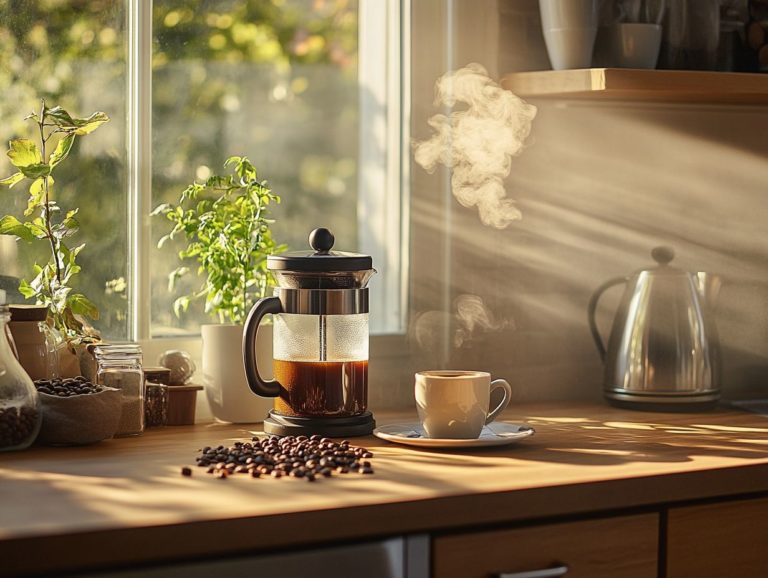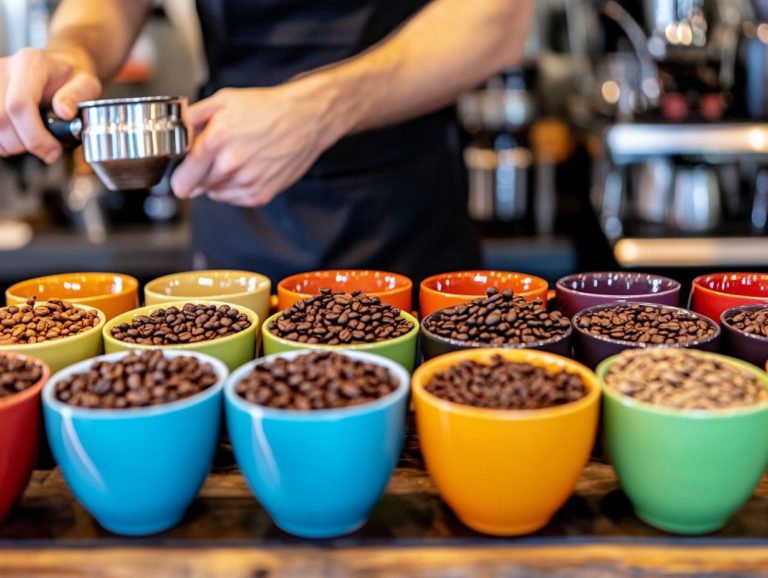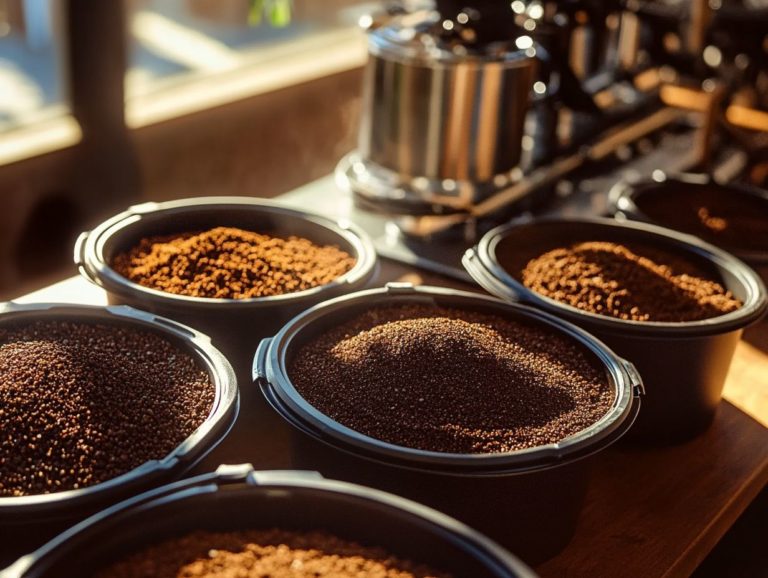Brewing Techniques: The Importance of Freshness
Contents
- The Importance of Freshness in Brewing Techniques
- Key Takeaways:
- The Importance of Freshness in Brewing Techniques
- How to Ensure Freshness in Brewing?
- What Are the Best Brewing Techniques for Freshness?
- 3. Aeropress
- 4. Cold Brew
- How to Tell If Your Coffee Is Fresh?
- 1. Check the Roast Date
- 2. Smell the Beans
- 3. Taste the Coffee
- What Are the Benefits of Using Fresh Coffee Beans?
- The Importance of Fresh Coffee
- Frequently Asked Questions
- What are brewing techniques and why are they important for freshness in coffee?
- How does freshness impact the taste of coffee?
- What factors can affect the freshness of coffee?
- Why is it important to use fresh ingredients in brewing coffee?
- How can I tell if the coffee I am drinking is fresh?
- Are there any benefits to drinking fresh coffee?
The Importance of Freshness in Brewing Techniques
When you aim to brew the perfect cup of coffee, freshness is paramount. The distinction between a mediocre brew and an extraordinary experience often hinges on the freshness of your coffee beans, which impacts the aroma, taste, and overall quality of the coffee.
This article delves into essential brewing techniques that highlight the importance of freshness, guiding you from the selection of whole beans to the most effective brewing methods, including pour-over, cold brew, and more.
Get ready to elevate your coffee game like never before!
Key Takeaways:

- Freshness is crucial for a perfect cup of coffee. Always use freshly ground beans and filtered water to preserve essential oils and flavors.
- Proper storage and grinding techniques are vital for maintaining freshness, flavor, and aroma over time.
- Fresh coffee beans offer superior taste, more nutrients, and higher caffeine content compared to stale beans, meeting consumer demand for quality coffee experiences.
The Importance of Freshness in Brewing Techniques
Freshness plays a pivotal role in brewing techniques, especially in beer production, where the quality of ingredients particularly hops dramatically shapes the flavor and aroma.
Renowned breweries like Sierra Nevada Brewing and Russian River Brewing underscore the significance of using fresh ingredients. Influential figures in the brewing community, such as Ken Grossman and Stan Hieronymus, advocate for homebrewing approaches that prioritize freshness.
The hop harvest season serves as a crucial reminder of the need for immediate processing and proper drying to capture essential oils and flavors that elevate the final product. The fermentation process thrives on the inclusion of fresh hops, directly influencing the overall quality, taste, and aroma of the beer crafted.
How to Ensure Freshness in Brewing?
To guarantee that your brewing remains fresh and vibrant, it s vital to adopt best practices that uphold the quality of both your ingredients and brewing environment. Fresh hops are essential for delivering the rich flavors and aromas that define exceptional beer. Proper storage techniques can dramatically influence their shelf life.
Whether you’re a homebrewer or a craft brewing enthusiast, it s important to focus on key elements like sourcing fresh ingredients, maintaining optimal storage conditions, and refining your brewing techniques. This careful attention enables you to produce high-quality beer that satisfies the growing consumer demand for freshness and quality in craft beer.
1. Buy Whole Beans and Grind as Needed
Purchasing whole beans and grinding them as needed is essential for maintaining the freshness and quality of your coffee. This method preserves the precious essential oils and flavors that can fade once the beans are ground and exposed to air, ensuring that the aroma and taste remain vibrant.
Freshly ground coffee delivers a richer flavor profile, enhancing your overall brewing experience and meeting the high standards of artisan coffee enthusiasts. The difference is striking when you compare it to pre-ground coffee, which often lacks the lively notes that freshly ground varieties bring to the table.
When choosing the right grind size, consider your brewing method. A coarse grind works wonders for a French press, while a fine grind is perfect for espresso machines. Understanding these brewing tips significantly impacts the quality and taste of your final cup.
Each grind size affects extraction coarser grinds lead to slower extraction and mellower flavors, while finer grinds result in quicker, more intense extractions. By grasping these nuances, you can enhance your coffee-drinking experience, transforming each cup from a mere routine into a delightful ritual.
Start experimenting with these brewing techniques today!
2. Store Beans Properly
Proper storage of coffee beans is essential for preserving their freshness and flavor. Exposure to air, moisture, and light can degrade their quality over time. To maintain the integrity of your beans, store them in an airtight container in a cool, dark place, away from direct sunlight and heat sources. This simple practice can make a big difference in your coffee experience!
The choice of storage container is crucial. Opt for opaque, non-reactive materials like ceramic or dark glass. These options prevent light from seeping in and help reduce the risk of unwanted chemical reactions. Humidity is another factor to keep in mind, as coffee beans thrive in a dry environment. Avoid placing them in the refrigerator or freezer, as this can introduce moisture and compromise their quality.
As a homebrewer, be mindful of your coffee supply. Buying in smaller quantities helps ensure that your beans are always fresh, maximizing flavor and aroma with each brew. Consider coffee subscriptions to receive fresh beans regularly and maintain a high-quality supply. Try these tips today and elevate your coffee game!
3. Use a Quality Grinder
Using a quality grinder is essential for achieving the perfect grind size for your coffee brewing. This can make or break the flavor extraction and overall quality of your drink. A well-designed grinder ensures that your beans are ground uniformly, preventing over-extraction or under-extraction during brewing.
Regarding grinders, you have options. Blade grinders and burr grinders operate differently. Blade grinders tend to chop the beans unevenly, while burr grinders crush them between two surfaces, providing a uniform texture that caters to various brewing methods from French press to espresso. Investing in a high-quality burr grinder can make a significant difference in your coffee experience.
Remember, the grind size you choose can dramatically influence your brewing technique. A coarse grind is key for a French press, allowing for balanced extraction. In contrast, a fine grind is necessary for making espresso, yielding rich, concentrated shots. By investing in a high-quality grinder, you re elevating the flavor profile of your coffee and tailoring your preparation to highlight specific notes in every exquisite cup.
4. Use Filtered Water
Using filtered water for your coffee brewing is absolutely essential to achieve the best taste and quality. Impurities in tap water can throw off the flavor profile of your final cup. Opting for filtered water removes chlorine, sediment, and other undesirable elements, allowing the natural flavors of your coffee beans to shine.
This simple practice can make a big difference in your coffee experience, guaranteeing that the freshness of your brew remains intact. The importance of using filtered water cannot be overstated, especially since different brewing methods can highlight a variety of notes and aromas in your coffee.
For example, the mineral content of the water plays a crucial role in enhancing these flavors. Choosing the right filtration method is vital. Whether you go for a charcoal filter, reverse osmosis, or a ceramic filter, each option presents unique benefits that contribute to a cleaner, more refined result.
Make sure your water is free from harmful substances this step is key to enjoying a delightful cup of coffee! By ensuring the water you use is pure, you can truly elevate your brewing process, resulting in a cup that is rich in taste and full of character.
What Are the Best Brewing Techniques for Freshness?

Brewing coffee is not just a task; it’s an art. Understanding the best techniques can drastically elevate your morning ritual. Best brewing techniques for freshness include proper grinding, water quality, and brewing ratios.
The finest brewing techniques for ensuring freshness revolve around methods that accentuate the inherent flavors and aromas of coffee, delivering an extraordinary tasting experience. You ll find that various brewing methods, such as pour over, French press, Aeropress, and cold brew, each present distinct advantages that can elevate the freshness and quality of your brewed coffee. By improving your brewing time and temperature, you can achieve a superior result.
By understanding these techniques, you enable yourself as a homebrewer or artisan coffee enthusiast to make informed choices about your brewing processes, ultimately enhancing the flavor and aroma of your coffee.
1. Pour Over Method
The pour-over method is a sought-after brewing technique that offers you precise control over both brewing time and temperature, resulting in a tasty cup of coffee. By pouring hot water over freshly ground coffee, you allow the water to extract essential oils and flavors more efficiently, enhancing the freshness of your brew. This method also invites a delightful sensory experience, as you can appreciate the aroma and taste of the coffee, making it a favorite among enthusiasts.
Using filtered water also improves this method. To truly master this technique, start by selecting high-quality coffee beans and grinding them just before you brew, ensuring maximum flavor retention. Aim for a medium-coarse grind size, akin to sea salt.
For water temperature, it s essential to target a range between 195 F and 205 F. Water that s too hot can scorch your coffee, while cooler water might under-extract those rich flavors.
Begin the brewing process by pre-wetting the coffee grounds to encourage blooming, which is the process where coffee grounds release carbon dioxide, enhancing flavor extraction. Then, gradually pour water in gentle circular motions, allowing it to drip through the grounds steadily for about three to four minutes. This method ensures optimal brewing time and brew quality.
By paying careful attention to these variables, particularly water temperature and brewing time, you can dramatically elevate the richness and complexity of your final brew. The pour-over method, a popular brewing technique, is not only an art; it s also a science that rewards your dedication with an exceptional cup of coffee.
2. French Press
The French press stands as a timeless brewing technique, celebrated for its ability to create a rich, full-bodied coffee by allowing the grounds to steep directly in hot water. This method maximizes the extraction of flavor and aroma from the coffee beans, resulting in a brew that truly retains its freshness and quality. By opting for a coarser grind size, the French press ensures that the essential oils of the coffee remain intact in your final cup, delivering a robust flavor profile that s hard to beat. Coffee lovers everywhere rave about this technique for its simplicity and flavor.
To prepare, start by boiling water and measuring your coffee grounds aim for about one ounce of coffee for every 15 ounces of water. Once you’ve added the coffee to the French press, pour hot water over the grounds, allowing the mixture to steep for four to five minutes. This brief steeping time is essential, striking the perfect balance for optimal flavor extraction while avoiding any bitterness. Ensuring quality control during this brewing process is key to achieving a delightful cup.
When your brew is ready, gently push down the plunger to separate the coffee from the grounds and serve it immediately. This technique not only elevates the overall quality of your coffee but also preserves its freshness, ensuring that each cup is a delightful experience you ll savor.
3. Aeropress
The Aeropress is a remarkable brewing device that seamlessly merges the finest elements of immersion and pressure brewing. It delivers a fresh and flavorful cup of coffee every time. With this method, you gain precise control over brewing time and temperature. This makes it an exceptional choice for anyone looking to elevate their coffee experience to new heights.
The Aeropress invites you to explore various grind sizes, brewing ratios, and techniques. This allows you to craft a personalized cup that suits your unique palate. This versatility makes it a favorite in artisan and craft brewing circles.
Its compact and lightweight design makes the Aeropress an ideal companion for travel or outdoor adventures. You can enjoy a premium coffee experience wherever you go. Whether you re in the mood for rich espresso-like shots, smooth Americanos, or even refreshing cold brews, this versatile device adapts effortlessly to your coffee preferences. It s a popular choice for homebrewing enthusiasts.
For optimal flavor extraction, start with freshly ground beans and fine-tune the water temperature around 200 F typically offers the best results. Experiment with brewing times; even a few extra seconds can profoundly enhance the overall taste of your final brew.
4. Cold Brew
Cold brew is a remarkable brewing technique that invites you to steep coarsely ground coffee in cold water for an extended period, typically between 12 to 24 hours. Get ready for a smooth and refreshing coffee concentrate that truly stands out from traditional hot brewing methods.
This approach reduces acidity and offers a sweeter taste profile while preserving the freshness and quality of the coffee. If you prefer a chilled beverage that doesn t compromise on the excellence of high-quality coffee, cold brew is your ideal choice.
To craft the perfect cold brew, a popular ratio is one part coffee to four parts water. Feel free to tweak it to suit your personal taste. During the steeping process, the coffee grounds gradually release their rich flavors into the water. This creates a concentrated liquid that you can easily dilute with additional water or milk before serving.
The finished beverage boasts a mellow, chocolatey undertone with subtle hints of nuttiness. This makes it especially delightful during those warm months. Thanks to the low-temperature brewing method, the coffee s natural oils and aromas are retained. You ll enjoy a fresh and vibrant experience with every sip you take. This method can be complemented with proper preservation techniques to maintain brew quality.
How to Tell If Your Coffee Is Fresh?
Determining whether your coffee is fresh is crucial for savoring the complete range of flavors and aromas it has to offer. To assess freshness, consider key indicators such as the roast date, the scent of the beans, and the overall taste profile. Using your senses to check for freshness can greatly aid in identifying the freshness and quality of your coffee.
Ideally, fresh coffee should be enjoyed within a few weeks of roasting. Its aroma and flavor should showcase the vibrant characteristics typical of high-quality coffee. By paying close attention to these details, you can ensure that you’re brewing coffee at its peak freshness. Don t miss out on the chance to experience the vibrant flavors of fresh coffee!
1. Check the Roast Date
Checking the roast date is one of the most effective ways to gauge the freshness of your coffee. After roasting, beans start to lose their optimal flavor and aroma within just a few weeks. For the best taste experience, aim to enjoy your coffee within 2-4 weeks post-roast.
When purchasing from local roasters who clearly label their roast dates, you can ensure that you’re savoring coffee at its freshest. Many coffee subscriptions offer freshly roasted beans delivered regularly, helping to maintain brew quality.
By prioritizing the roast date, you unlock the full spectrum of flavors that a well-roasted bean has to offer. Nothing compares to the vibrant taste of fresh coffee! Fresh coffee boasts enhanced aromas and delightful complexity that older beans simply can’t replicate.
When shopping for coffee, especially from retail chains or online sources, look for brands that prioritize transparency in their labeling and prominently display roast dates. Engaging directly with local coffee shops improves your understanding of the sourcing and processing methods, which significantly impact the quality of your brew.
So, keep an attentive eye on those crucial dates and make informed choices to elevate your daily coffee ritual.
2. Smell the Beans

The aroma of coffee beans serves as a powerful indicator of their freshness and quality. When you encounter freshly roasted beans, the rich and complex scent they emit reveals the presence of essential oils and flavors.
Take a moment to inhale deeply; if the beans have a dull or flat aroma, it suggests that they may have lost their vitality. Engaging your sense of smell is not just an indulgence it’s an essential step in assessing the quality of your coffee before you even think about brewing. This is a crucial part of quality control in the art of brewing coffee.
To truly appreciate the intricate nuances of the aroma, consider employing specific techniques like cupping, which is a method of tasting coffee to assess its flavors, or grinding a small amount of beans before smelling. These methods beautifully enhance the release of volatile compounds.
As you inhale, pay attention to the various layers of fragrance; you might detect delightful notes of chocolate, fruit, or even nuttiness, all of which contribute to the coffee’s overall taste profile. Ensuring that your grind size is appropriate can also enhance the sensory experience.
The importance of aroma extends well beyond mere enjoyment; it plays a crucial role in brewing that perfect cup. The quality of the beans directly impacts the final flavor and the satisfaction you experience with each sip.
3. Taste the Coffee
Tasting coffee is the ultimate test for you to gauge its freshness and quality, as the flavor profile speaks volumes about the condition and age of the beans. Fresh coffee should greet you with a vibrant, well-rounded taste, showcasing distinct flavors without any hint of bitterness or dullness.
Applying sensory evaluation techniques can further enhance your understanding of the quality and freshness of the coffee. Engaging in a tasting session allows you to truly appreciate the intricate flavors that fresh coffee has to offer, underscoring the significance of using quality ingredients in your brewing process.
Techniques such as pre-pasteurization and degassing can also help in maintaining the quality of your beans. To elevate your experience, gather a selection of coffee beans sourced from various regions. This diversity will beautifully highlight the unique characteristics each origin brings to the table.
Begin by inhaling the aroma of the ground coffee; the scent can reveal a great deal about its freshness and flavor potential. Next, take small sips, allowing the coffee to envelop your palate. This method will help you pinpoint specific notes, whether they are fruity, nutty, or floral.
Using a quality coffee grinder can significantly enhance this sensory experience, ensuring a consistent grind that brings out the best in each cup. Encouraging a systematic approach to note-taking will enable you to track these flavor nuances, enriching your personal enjoyment and deepening your overall appreciation for the vast and captivating world of coffee.
Try these tips today, and taste the difference in your next cup of coffee!
What Are the Benefits of Using Fresh Coffee Beans?
Using fresh coffee beans brings a wealth of benefits that elevate your coffee drinking experience to new heights. You’ll notice improved flavor and aroma alongside a boost in nutrient content. The use of proper brewing equipment can further maximize these benefits.
Fresh beans preserve a vibrant and intricate flavor profile, resulting in a cup of coffee that is enjoyable and rich in essential oils and antioxidants. Fresh coffee tends to have higher caffeine levels and a reduced bitterness, making it an exceptional choice for both enthusiasts and casual drinkers. Proper preservation techniques, such as keeping them in an airtight container, can help maintain the quality of your fresh beans.
1. Better Flavor and Aroma
Ensuring the right brewing temperature can also play a significant role in maximizing the flavor and aroma of your coffee. Techniques such as letting the coffee breathe and allowing it to settle can enhance these sensory attributes, making each cup a delightful experience.
Fresh coffee beans are your ticket to a superior flavor and aroma. They preserve the essential oils and compounds that create a truly rich coffee experience. When you brew fresh beans, you unlock a vibrant taste profile loaded with distinct notes and complexities that older beans simply can’t deliver.
The aromatic qualities of fresh coffee reach their peak, providing an enticing sensory experience that elevates your enjoyment! Using fresh beans in various brewing methods like pour-over or cold brew can significantly enhance this experience. Don’t settle for flat, dull coffee! Experience the vibrant taste and aroma of freshly roasted beans!
On the flip side, coffee that has been languishing on the shelf for weeks or even months loses its aromatic vitality, resulting in a flat, dull flavor that lacks depth. The freshness of the beans significantly impacts the balance of acidity, sweetness, and body in your cup, making it crucial for coffee enthusiasts like you to seek out freshly roasted options.
This difference is particularly striking in single-origin coffees, where the unique characteristics of the bean truly shine when brewed soon after roasting. If you re serious about savoring coffee at its finest, prioritizing freshness is essential to unlocking the full spectrum of flavors and aromas that these exquisite beans can provide. Many coffee subscriptions emphasize the importance of freshness, delivering freshly roasted beans right to your door.
2. More Nutrients and Antioxidants in Fresh Coffee
Fresh coffee beans pack a powerful punch when it comes to nutrients and antioxidants, far surpassing their older counterparts, which tend to lose their beneficial properties over time. These compounds are vital for your health and well-being, significantly enhancing the quality of your coffee experience.
By opting for fresh coffee, you not only savor a more delicious beverage but also reap the health benefits that come with higher antioxidant levels. Antioxidants are your body s defenders against free radicals, playing a pivotal role in reducing inflammation and lowering the risk of chronic diseases.
The nutrients found in fresh beans, including essential vitamins and minerals, further elevate the drink s health-promoting potential. Freshness is critical in maximizing these advantages; as coffee beans age, their complex flavor profiles and potent health benefits decline. This makes a freshly roasted cup an unparalleled choice for those who appreciate high-quality, artisan coffee.
By being discerning about your coffee selections, you indulge in an exquisite sensory experience while supporting your health with the enhanced properties found in freshly sourced beans. Choose fresh coffee for an unparalleled taste experience and optimal health benefits!
The Importance of Fresh Coffee
3. Higher Caffeine Content in Fresh Coffee
Fresh coffee beans often pack a higher caffeine content than their older counterparts. This significantly elevates your coffee-drinking experience.
This boost in caffeine not only enriches the flavor but also enhances your alertness and energy levels. For many coffee lovers, the quest for a powerful cup is a compelling reason to prioritize fresh beans in their brewing routine.
Utilizing proper brewing techniques will also aid in extracting the maximum caffeine content and flavor from fresh beans.
The freshness of the beans is essential for preserving the vital oils and compounds that shape the overall flavor profile. When you grind freshly roasted beans, they release aromatic compounds that transform your coffee into more than just a beverage it becomes a moment to truly savor.
By paying attention to brewing temperature and grind size, you can enhance these aromatic compounds even further.
On the flip side, older beans can lead to a lackluster taste and diminished caffeine kick, ultimately affecting your satisfaction. By choosing freshly roasted coffee, you not only energize your body but engage your senses, elevating your daily coffee ritual to something truly special.
Fresh beans are especially important for brewing coffee using methods like pour over, which can highlight the intricate flavors and aromas.
4. Less Bitterness in Fresh Coffee
One of the standout advantages of using fresh coffee beans is the significant reduction in bitterness, a common issue with older beans.
When you indulge in freshly roasted coffee, you’re treated to a delightful balance of natural flavors. The sweet and complex notes come to life, while any undesirable bitter aftertastes are kept at bay.
This quality enhances your overall drinking experience, making fresh coffee the favored choice among many coffee lovers and homebrewing enthusiasts.
The connection between freshness and bitterness hinges on the chemical compounds found in coffee. As time passes, beans undergo oxidation, a chemical process that happens when coffee beans are exposed to air.
This process leads to the breakdown of certain acids and oils that contribute to flavor. These changes can amplify the bitter compounds, overshadowing the coffee’s more subtle characteristics.
However, when beans are freshly roasted and stored properly, those volatile compounds remain intact, preserving the vibrant flavors that should ideally define each cup.
Proper preservation techniques, such as degassing and airtight storage, are key to maintaining these qualities.
By choosing fresh coffee, you not only savor a smoother taste but also enjoy a well-rounded flavor profile that showcases a delightful array of tasting notes. This practice aligns with quality control measures often employed by craft brewing experts.
Frequently Asked Questions

What are brewing techniques and why are they important for freshness in coffee?
Brewing techniques are the steps you take to make great coffee, from choosing the right ingredients to brewing them perfectly. These techniques are crucial for ensuring the freshness of the coffee, as they determine the quality and flavor of the final product.
Factors like brewing time, temperature, and grind size are vital in crafting a perfect cup.
How does freshness impact the taste of coffee?
Freshness plays a crucial role in the taste of coffee. When coffee is fresh, it has a vibrant, rich taste with a strong aroma.
As it ages, the flavor can become stale and bitter, diminishing the overall taste experience.
What factors can affect the freshness of coffee?
Several factors can impact the freshness of coffee, including exposure to light and oxygen, temperature fluctuations, and the age of the ingredients used in the brewing process.
Using proper storage techniques and consuming coffee before its optimal freshness period ends is essential to maintain quality.
Why is it important to use fresh ingredients in brewing coffee?
The quality of ingredients used in brewing coffee directly affects the freshness of the final product. Fresh, high-quality ingredients provide a better flavor and aroma to the coffee.
Using expired or low-quality ingredients can result in a stale and off-flavored cup.
How can I tell if the coffee I am drinking is fresh?
There are a few signs to look for to determine the freshness of coffee. These include:
- A vibrant aroma
- A rich and robust flavor
- A smooth and clean taste
It is also important to check the roast date and purchase from a reputable source.
Are there any benefits to drinking fresh coffee?
Yes, there are several benefits to drinking fresh coffee:
- Fresh coffee has a more robust and complex flavor profile,
- A stronger aroma,
- A smoother texture.
It also contains more nutrients and antioxidants, making it a healthier choice compared to aged coffee.






